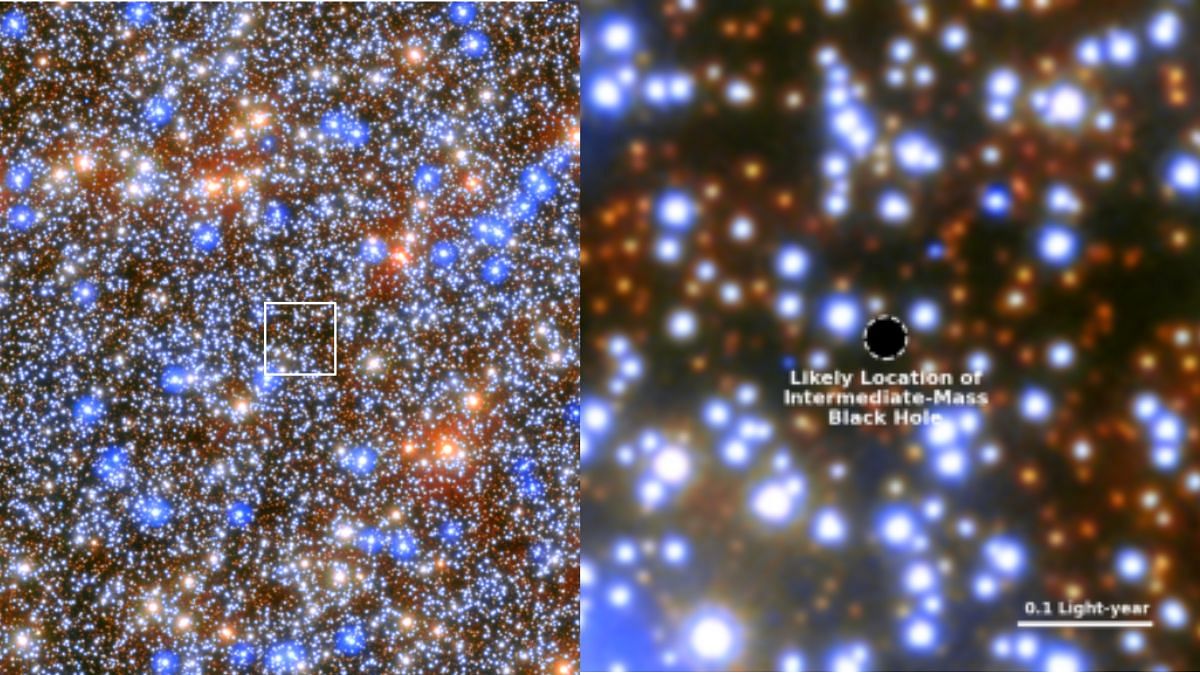New Delhi: A team of astronomers led by a group from the Max Planck Institute for Astronomy in Heidelberg, Germany, has identified a long-searched member of the black hole family — an intermediate-mass black hole (IMBH) in Omega Centauri, the most massive star cluster of the Milky Way galaxy.
The peer-reviewed results were published Wednesday in the journal Nature.
This discovery provides strong support to the age-old theory regarding galactic evolution, which proposes IMBH to be the building blocks of supermassive black holes.
In astronomy, black holes, based on their masses, can be categorised as stellar-mass, supermassive, and intermediate-mass. Stellar black holes, with masses between one and few dozen solar masses, and supermassive black holes, with masses of million or even billion solar masses, are well-known. IMBH, with masses between 100 to 100,000 times the mass of the Sun, have been notoriously hard to find, until recently.
According to a statement released by the Max Planck Institute of Astronomy, the black hole at the heart of Omega Centauri appears to be the “missing link” between stellar and supermassive black holes which is frozen in an intermediate stage of evolution.
The IMBH is significantly less massive than the black holes typically found in the centres of galaxies.
This IMBH is estimated to be 8,200 times the mass of the Sun, and adds evidence to the theory that Omega Centauri was a galaxy with a core that was swallowed by the Milky Way, stopping the growth of the black hole at intermediate mass.
Also read: Fossil of extinct human species Denisovan identified in Tibetan plateau, their diet pattern revealed
Hubble reveals stars around hidden black hole
This discovery was made possible by tracking the fast-paced stellar movements — the tipping-off signal of a gigantic black hole in the bulky crowded centre of the globular star collection of Omega Centauri, located at a distance of about 18,000 light years from the Sun.
Omega Centauri is a massive collection of around 10 million stars and is visible to the unaided eye from the southern latitudes of Earth as a speck in the night sky. Through a small telescope, it appears as a spherical collection of stars called globular clusters. These are so dense in the middle that it becomes impossible to tell them apart.
Based on an earlier statement by the Max Planck Institute of Astronomy, this new study led by Maximilian Häberle from the institute has confirmed long-standing suspicions of astronomers that Omega Centauri harbours a central black hole.
Using precision-based techniques, Häberle’s team analysed over 500 images of Omega Centauri to detect the tiniest star motions in crowded central regions. Most of these pictures captured by the Hubble Space Telescope (HST) for over 20 years were initially produced to calibrate the instrument.
However, these very images helped the scientists make the biggest discovery of their time. With ever-repeating views of Omega Centauri, they served as a perfect dataset which led the researchers to unearth a small subset of seven fast-moving stars by closely monitoring the movements of almost 150,000 stars.
These stars have differing speeds and directions.
Why the stars have high speeds
The presence of a concentrated mass in the proximity of stars could explain their high speeds, as they whip around the central mass.Whether this mass was a mere collection of single stars or a massive central black hole was a question that required careful analysis.
The study found the estimated velocities of these rapidly moving stars to be significantly higher than the escape velocities of the Omega Centauri, which refer to the minimum velocities required to escape the gravitational force of any celestial body.
His team performed a broader analysis that helped them determine that there is a central mass in Omega Centauri, which is equivalent to at least 8,200 solar masses. Moreover, the images do not identify any visible location at the deduced location of the central mass. This is what would be expected of a black hole.
The authors said that further observations are needed to test their hypothesis that Omega Centauri was a swallowed galaxy, and also stressed on the need for direct observation of the IMBH.
(Edited by Radifah Kabir)
Also read: Martian missions, astrophysics advances — why the West just can’t ignore Chinese science now

